"I was the spark that lit up Flaming Youth," wrote
F. Scott Fitzgerald, "Colleen Moore was the torch. What little things we were to have caused all that trouble."
In 1926, the heyday of Mary Pickford, Douglas Fairbanks
and Charlie Chaplin, the number one box office attraction in the country was a spirited young actress named Colleen Moore,
and the "trouble" she caused began with the most fateful haircut since Samson's. A few years earlier, in order to wangle
a part in a movie, she had bobed her hair. When she appeared on the screen with her shorn locks, audiences gasped.
Filmdom's first flpper was born. . . .+
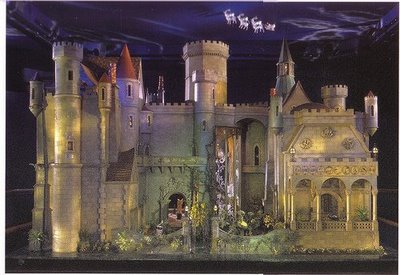 The idea for my own fairy castle--a miniature
fairy castle--came not from Mr. Hearst [who had built his own castle at San Simeon] but from my father, though my doll house
has the same feeling about it as San Simeon [William Randolph Hearst's Castle, http://www.hearstcastle.org]. When Hedda Hopper first saw it, she turned to me and said,
"It's plain to see you've been to the Hearst ranch."
The first doll house I ever had was one my mother
and father made for me out of cigar boxes when I was two years old, though I know now they didn't make it for me so much as
for he fun of doing it. They even made the furniture.
Through my childhood Dad made four more doll houses,
each more elaborate than the last.
Toward the end of my marriage to John, Mother
and Dad and I went to Hawaii for a few weeks in the hope that my being away from John for a while could straighten out his
drinking problem. One day on the boat going over, Dad said, "why do't we build a fairy castle to house your collection?"
Kathleen's Collection, started those many years
ago by my aunts, had, with additions my me and by friends in late years, grown into a really fine collection.
"This time," Dad went on, "let's get an architect
and artists and build a work of art."
We hardly saw the beach at Waikiki. We couldn't
wait to get home. Horace Jackson, who designed the sets at First National, was our choice for architect. He was
enchanted with the idea. It was his suggestion that the architecture be unreal, making the castle look as if it had
come from the pages of a storybook. Harold Grieve was consulted as decorator. He said the name of the period for
the furniture should be Early Fairie. He went on to say that the princess who lived in the castle must like antiques.
She would to to the antiques shops of fairlyand to find her furniture--King Arthur's round table for the dining room,
Sleeping Beauty's bed for her bedroom. This was the premise on which we furnished the house.
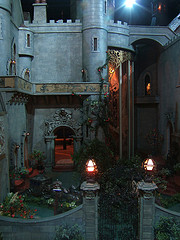 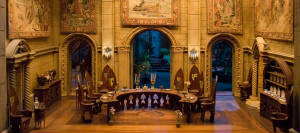 I
had the best time I had ever had in my life when we were creating the doll house, as we then called the castle. Dad
was in his element bossing every nail and joint as chief engineer. He rented an empty shop in Glendale to do the work,
saying this doll house must be engineered so the rooms came apart and not end up like doll house number four. Number
four was built in the attic playroom. When we moved, we couldn't get it through the door. He also said it usn't
be build like doll house number five, which warped in spite of the wood being plied four times. This house must be made
of aluminum, because aluminum was light as well as strong. (Even so, the fairy castle, which measures nine feet square,
its highest tower twelve feet from the floor, weighs close to 2000 pounds!)
The plans were drawn, the scale one inch to the foot.
When Horace Jackson was seen wandering around the studio with a far-away look on his face, people would say, "Don't mind Horace.
He's just getting rid of his repressed desires in Colleen's fairy castle." The whole studio knew about my folly, as
I also then called it. Much of the work was done by miniature workers at First National--men who made the scaled-down
objects often used in movies for depicting fires, floods, earthquakes, and other great and otherwise too costly catastrophes.
Each Room was built in wood first, then cast in aluminum.
We were told this was the first time aluminum had been used for casting. It was done through what is called the lost
wax process, which permits very fine detail in carvings. When each room came back, a jeweler polished off the rough
edges and made it ready for painting. Finally we had the complete shell. Next it had to be decorated and furnished.
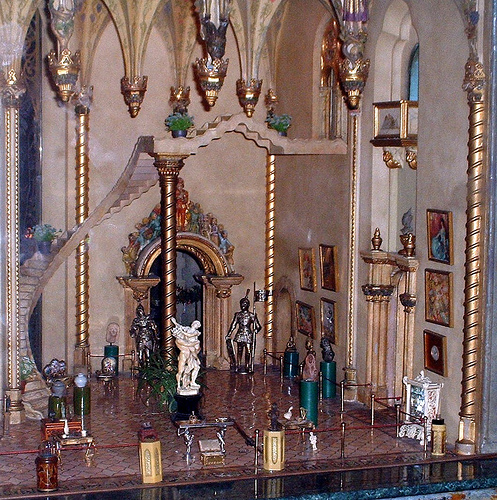 The fairy castle
is fantasy throughout. We would say, "What wouldn't peole have?" Dad would say, "People wouldn't have a drawing-room
floor made of rose quartz and jade." I sent a sketch to Yamanaka's in New York, the famous collectors of Oriental art,
and they sent it to Peking, China. Nine months later my floor came home.
News got about that I was building a completely mad
doll house. My friends James Montgomery Flagg and Arthur Wiliam Brown were in California again, so I took them to see
it. Hanging in the unfinished drawing room was a small brass chandelier trimmed with crystal beads. Jim said,
"That's no fairy chandelier. If it were, it would be made of gold and hung with diamonds."
Delighted with the idea, I took the brass one
to Mr. Crouch, a Beverly Hills jeweler who had great imagination, asking him to copy it in gold. Then I held out a handkerchief
filled with my jewels. "And please put these on instead of the beads."
He looked at me as if I were from another planet, then,
fingering the emerald bracelet, the Oriental pearl chain, the square cut diamond ring, the necklace, he said, "It could
be very interesting." He took the jewels out of the handkerchief but handed me back a chain from which hung a six-carat
pear-shaped diamond. "Take this home," he said. "You must keep something."
Two weeks later he called me and said, "Bring back that
pear-shaped diamond. I need it for the drop at the bottom if the fixture." He had joined the club. The Goofus
Club, we called it, because everyone who worked on the castle went slightly balmy.
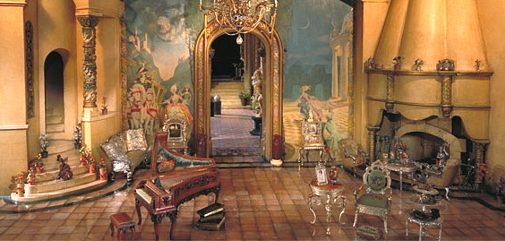 I wanted real electric
bulbs for the chandelier. Everyone said this was impossible, because no globes were made to my scale. I went to
a surgical supply company and asked if there wasn't an instrument which I'd read about in Time magazine
for photographing the interior of the stomach which used a globe the size of a grain of wheat. They showed it to me--a
tiny bulb which screwed into a socket. I took the name of the manufacturer, the Chicago Miniature Lamp Works, and wrote
to them. When they received my letter, they phoned me to say they would love to work on the lighting, that they not
only made grain-of-wheat bulbs but other small ones, and if necessary, they'd invent some new ones for me. They,
too, had joined the club.
Sidney Hickox, my cameraman, came over one night with
spotlights and laid out the indierect lighting effects. Jerry Rouleau, a master electrician, carried out the plan.
More than two hundred people worked on the house at one time or another.
And everyone had ideas. "Punch a bigger hole in
the weeping willow tree in the garden," someone would say. "It isn't crying fast enough." "Aladdin could never
get through that trap door," somebody else would point out. "It's too small. His shoulders are a good two inches
wide." Nothing was too expensive, nothing too difficult to get. From Start to finish, the fairy castle took sever
years and cost almost half a million dollars.
[That "almost" $500,000 cost at the time Moore's
house was finished in 1935 would cost almost $8,000,000 in 2009 - 2010.]
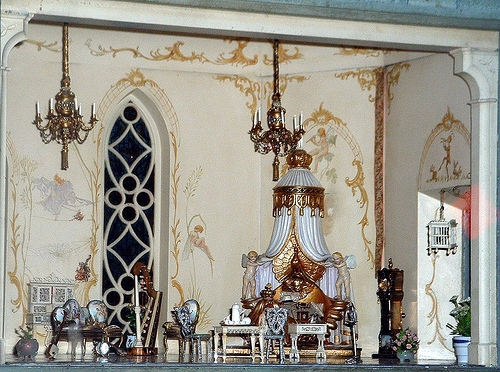 The
castle, which comes apart into two hundred pieces--with each room a separate unit--fits together like a Chinese puzzle.
It has a complete water works system. Distilled water is released from a tower on top of the castle and circulated over
and over through the use of centrifugal pumps. A complete electrical system lights the house, with the electrical and
waterworks system also coming apart at each room. Inside the castle are nearly two thousand small objects from all over
the world--many of them added in the years since its "completion."
To give you an idea of the fairy castle, let me describe
the bedroom of the fairy princess. The room is about two feet long and a foot and a half wide. The height is amost
two feet. We discovered, after throwing away a couple of models, that in miniature rooms one has to go overscale in
height to give the appearance of reality. To the eye, the height of the room looks about fourteen inches at most.
The big problem was what to use for a floor. It had
to be a romantic floor that woule be right for a tiny princess to walk on in her bare feet. At church one Sunday I looked
down at the cover of my childhood prayer book and found the answer. A floor was made of small pieces of mother-of-pearl
with a gold inlaid border.
The walls are a very pale pink. Over the door
leading to the crystal and silver bathroom is a mural of Peter Pan. In the back wall there are two stained glass Gothic windows
picturing happy songbirds, the windows very tall and narrow and of differnt heights to give a storybook look. Between
the windows stands a tiny ivory spinet.
The boat-shaped bed which belonged to Sleeping Beauty
is made of gold, the bedspread the golden spider web which covered her during her hundred-year sleep.
By the bed is a pair of red satin slippers with leather
soles and heels. They were made by an Italian shoemaker who wanted to see if a pair of shoes could be made size double
zero. Even for fairyland this is small. He, of course, qualified for the club.
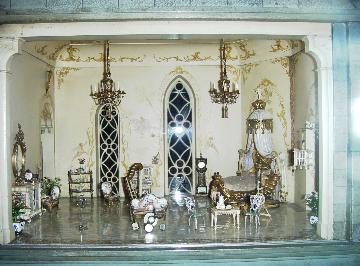
The dressing table is made
of carved ivory. On top is a gold toilet set, with the handles of the mirror and brush made of platinum set with diamonds,
and on the back of each a wee platinum crown. I had difficulty finding anyone who would make a set as small as our miniature
scale required. The bristles of the brush presented the greatest problem. Even a human hair was too coarse.
Finally Guglielmo Cini, a well-known Boston jeweler, undertook the job.
One day his wife came home in the late afternoon and
stood for a moment in the doorway, the sun hitting the fox fur piece she was wearing. Cini looked up and yelled, "Don't
move!" With a scissors he trimmed off the very fine white guard hairs, using them for the bristles in the brush.
The complete toilet set consists of comb, brush, mirror,
nail file, and two boxes each smaller than the nail on my little finger--one for powder, the other a jewel box. When
Mr. Cini handed me the jewel box he said, "Look inside. I've given the princess a present." Inside was a minute
engagement ring with a full-cut diamond--not a chip--the smallest full-cut diamond he could find in the markets of the world.
The ring is so small it won't go all the way down on a common pin. Mr. Cini had also joined the club.
In the front of the princess' bedroom is a small ivory
table with a chair on each side. When I was showing the castle once to a prominent jeweler in Des Moines, Iowa, I pointed
to a pair of diamond and emerald clips I was wearing and said, "Everything I won in jewelry is in the castle except these
clips."
He said, "They don't look like clips to me. They
look like chairs."
I took them off, and he turned them into platinum chairs
with backs of diamonds and and emeralds. Those are the chairs by the table.
Nearby is an ivory spinning wheel--the one Sleeping
Beauty pricked her finger on. An ivory harp is, of course, "the harp that once through Tara's halls." The other
chairs in the room are of Battersea enamel--the ones given to my by the aunts when I was a child.
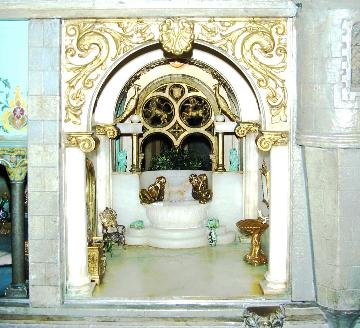 The castle is rich through out in the lore of
fairy tales. In the courtyard stands Cinderella's coach. In the great hall the goose that laid the golden eggs
sits on a tiny gold and enamel table, a gold mesh basket holding several golden eggs beside her. Under a glass bell
on a rosewood table nearby stand the chairs belonging to the Three Bears. each chair rests on the head of a pin,
the largest chair weighing only 150,000th of an ounce. Next to the chairs are etched glass windows overlooking the garden
telling the stories of Jack and the Beanstalk, Prince Charming, and the Princess and the Seven Swans. Mother
Goose characters adorn the walls of the kitchen, the copper stove there is the one in which the wicked witch locked Hansel
and Gretel.
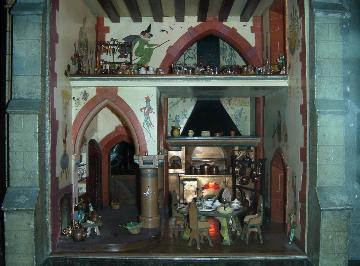 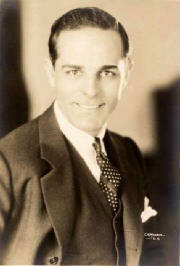 The library is filled with
tiny, tiny books. In the mid-1800s the printing of miniature books from real type was a widespriead hobby. I have
collected nearly a hundred of these small treasures. Included in the collection is the smallest Bible in the world,
printed in 1840 and given to me by Antonio Moreno after he played opposite me in Her
Wild Oat (1927).
My modern library is my most cherished posession.
I have had made up scores of beautifully bound books with blank pages not quite an inch in size. Many of my friends
have been helpful in getting their author friends to handwrite in these small books. Robinson Jeffers wrote an origial
Irish poem--quite gay and laughing in contrast to his dramatic Roan Stallion and The Women at Point Sur.
Sinclair Lewis made up a small sotry about Arrowsmith going to Hollywood to try to break into the movies. There are
books by Conan Doyle, Louis Bromfield, Booth Tarkington, Elinor Glyn, Willa Cather, Clare Boothe Luce, John Steinbeck, Thornton
Wilder, Adela Rogers St. Johns, Edna Ferber, Fannie Hurst, Daphne du Maurier, Irving Stone, Edward Albee, and, of course,
F. Scott Fitzgerald. And many more--nearly a hundred of the most famous authors of our time.
The Library also contains a postage-stamp size autograph
book. I am very snobby about this book. Each name in it is that of someone who has made a real contribution to
twentieth century history. Orville Wright for aviation. J. P. Morgan for finance. Henry Ford for business.
(Remember when he startled the world by doing so radical a thing as to pay five dollars a day to labor!) Wally and the
Duke of Windsor, the romance of our age. Admiral Richard E. Byrd for adventure. All the Presidents since Hoover
except Kennedy (I thought I had time--he was so young). Einstein, Churchill, Eisenhower, Pershing, Nehru, De Gaulle,
Queeen Elzabeth II, the Crown Prince of Japan, and so many others.
In the Drawing Room are several music scores handwritten
by their composers--among them Rachmaninoff's Prelude, Gershwin's Rhapsody in Blue, Stravinsky's Firebird
Suite, Rodgers and Hammerstien's Oh, What a Beautiful Monin'!, Irving Berlin's Alexander's Ragtime Band,
and a special favorite of mine, West Side Story, by Leonard Bernstein and Stephen Sondheim--Stephen being the son
of my longtime friend Foxy Sndheim.
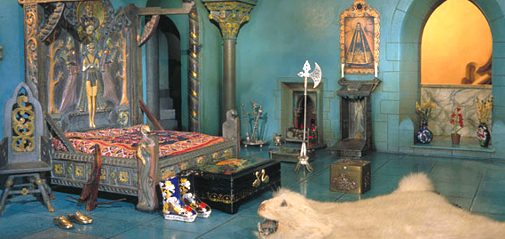 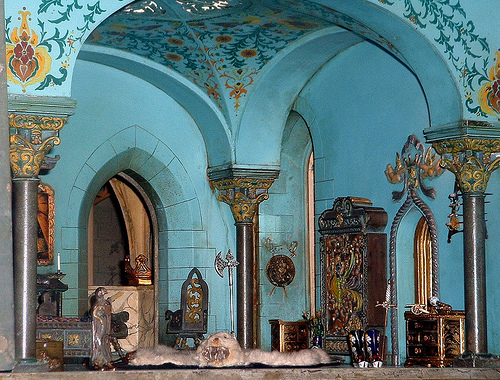 Of the many stories connected with furnishing the fairy castle, one of my favorites concerns the
rug on the floor of the prince's bedroom. I took an ermine skin to a taxidermist and asked him to make it into a bearskin
rug, head and all. He said he could make the bear's head, but not with his mouth open, because he couldn't think of
any way to duplicate the bear's teeth in miniature (this was before the age of plastic). When I went to pick up the
rug I was astonished to see the bear's mouth yawning wide and filled with white, wicked-looking teeth. The taxidermist beamed
at me. "I caught a little mouse," he said, "and used his teeth."
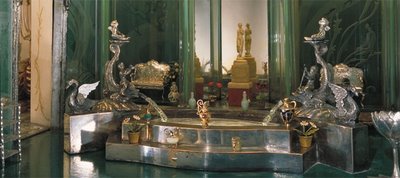 We decided not to put any figures in the doll house. When we tried, the dolls looked static and dead.
With an empty castle and a full imagination, it's easy to people the rooms with running, laughing elves and fairies.
(I have often asked children looking at the doll house what they liked best, and oftne the answer has been, "I liked best
the little fairy who was baking a cake in the kitchen," or "I liked best the little fairy who was playing the organ in the
chapel.")
The caslte was started in 1928 and finished in 1935. I had built it for my own amushement--and
amazement--regarding it as a beautiful toy, an extravagance, a folly, even, but one which had brought me more happiness then
I'd ever known before.
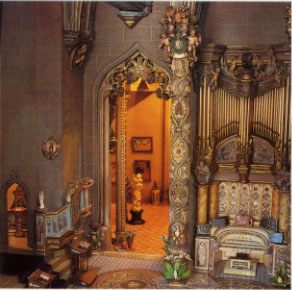
Some more links about La Belle Moore nd her Castle**:
"A magical audio tour":
A map to the Fairy Castle:
More Moore links:
A pretty complete video tour:
+Silent Star: Colleen Moore; Doubleday & Company,
Inc.; Garden City, New York; 1968; front dust jacket flap.
*Silent Star: Colleen Moore; Doubleday & Company,
Inc.; Garden City, New York; 1968; pages 231 - 245.
**Videos of Colleen Moore herself:
Ella Cinders (1926):
Orchids and Ermine (1926):
|

